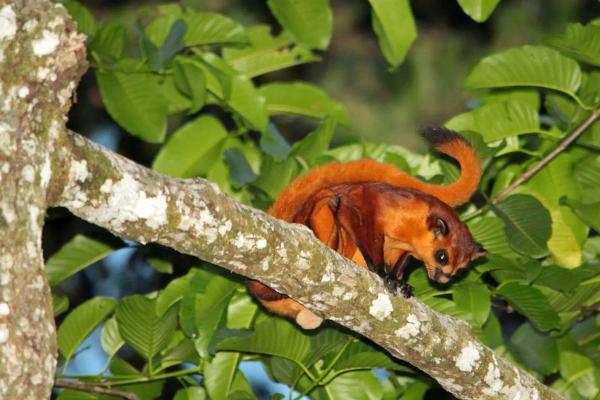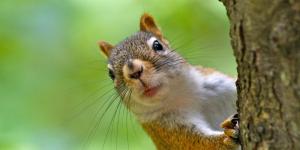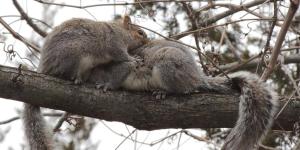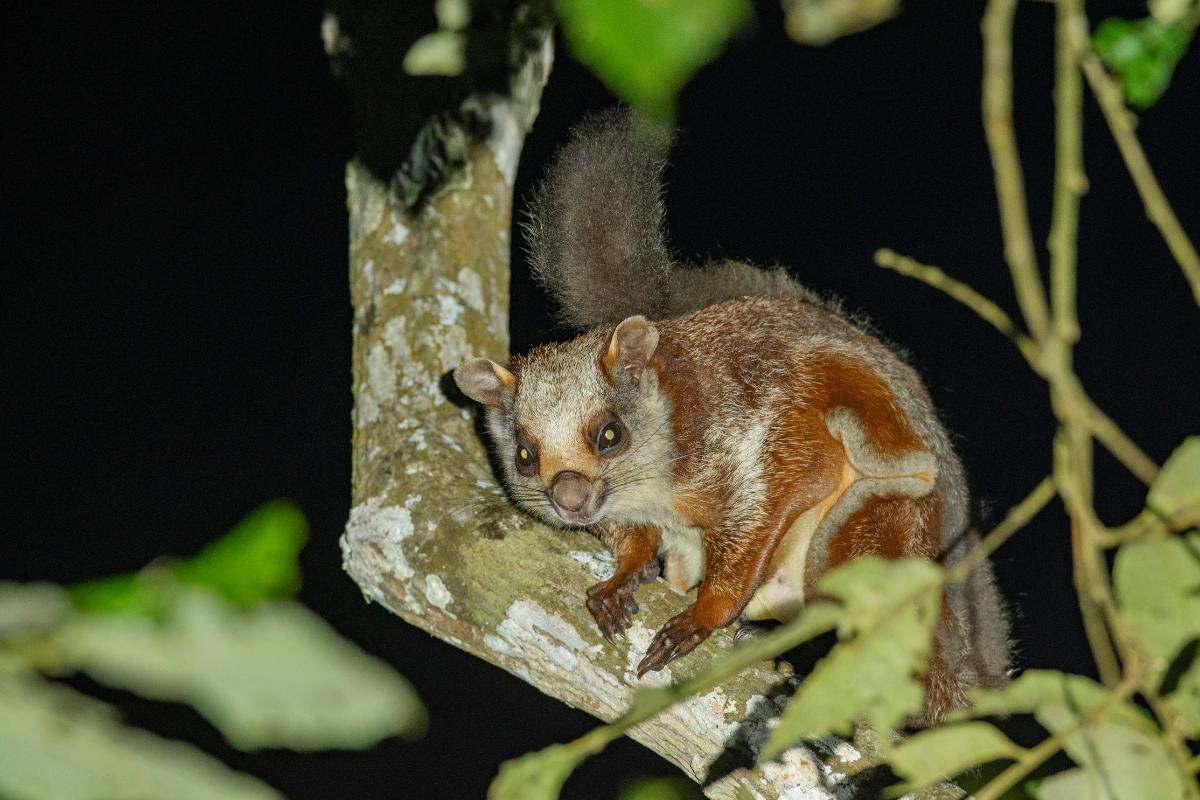Different Types of Flying Squirrels


Flying squirrels are a type of squirrel with unique adaptations to surviving in their environment. Squirrels can live in trees or on the ground, but flying squirrels are distinct for their ability to glide between trees. They are not a true flying mammal like the bat, but they have a membrane of skin between their limbs similar to a wing. Known as a patagium, they fan out this membrane when in the air to glide as if they were using a parachute. Despite not capable of true flight, they are able to maneuver in the air to create very accurate glide patterns.
Although they all have this gliding ability, there are many different types of flying squirrels. AnimalWised shares these flying squirrel species with photos and information about each.
- Northern flying squirrel (Glaucomys sabrinus)
- Southern flying squirrel (Glaucomys volans)
- Indochinese flying squirrel (Hylopetes phayrei)
- Red-cheeked flying squirrel (Hylopetes spadiceus)
- Red giant flying squirrel (Petaurista petaurista)
- Giant spotted flying squirrel (Petaurista elegans)
- Indian giant flying squirrel (Petaurista philippensis)
- Black flying squirrel (Aeromys tephromelas)
- Javanese flying squirrel (Iomys horsfieldii)
- Smoky flying squirrel (Pteromyscus pulverulentus)
- Other flying squirrels
Northern flying squirrel (Glaucomys sabrinus)
The northern flying squirrel can be found in Canada, Alaska and a few other territories in the United States. They mainly live in coniferous and mixed forests, but have been present in deciduous and riparian forests to a lesser extent. Being close to water is important, so they are found near various rivers, lakes and other bodies of water. They measure 10-15" (25-37 cm) in length and weigh 75 to 140 g.
As with all types of flying squirrel, the northern flying squirrel has a patagium that runs from the wrist of the forelimbs to the ankle of the hindlimbs. They are particularly abundant in their natural habitat and considered as being of least concern in terms of conservation. Their fur is gray with cinnamon brown.

Southern flying squirrel (Glaucomys volans)
The southern flying squirrel is of the same genus as the northern flying squirrel. The only other member is the Humboldt's flying squirrel (Glaucomys oregonensis), with these three species being the only flying squirrels found in North America. The southern flying squirrel is found in Canada, the United States, Mexico, Guatemala and Honduras.
Its preferred habitat is deciduous and mixed forests, particularly beech, maple, oak, walnut and poplar forests. It can also be found in orchards. Its maximum length is 11" (28.5 cm) its maximum weight is 90 g. The fur under the nose and belly is whitish, while the upper fur is greyish brown. Their patagium is edged with black hair. It can be distinguished from the northern species by the color of its ventral fur.

Indochinese flying squirrel (Hylopetes phayrei)
Also known as Phayre's flying squirrel, this type of flying squirrel is native to China, Myanmar, Thailand and Vietnam, although it has also been seen in Laos. It lives mainly in low deciduous and mixed forests, but can also be found in cleared forests near crops.
They are a white flying squirrel on the ventral part, but their dorsal side can be gray, dark brown or even reddish in color. These gliding rodents are one of the smallest flying squirrels in China, measuring 6.9-7.4" (17-19 cm) and weighing up to 180 g.
Learn more about the habitat of these rodents with our article asking where do squirrels live?

Red-cheeked flying squirrel (Hylopetes spadiceus)
Another Asian flying squirrel of the same genus, this type is native to Brunei, Indonesia, Laos, Malaysia, Burma, Singapore, Thailand and Vietnam. Its habitat can be primary forests, degraded secondary forests and scrublands. As with other examples of flying squirrels, it has arboreal habits, gliding from one tree to another.
Its fur is orange or brown, with brighter cheeks and tail. Its hairy patagium is made up of sheets of muscle. Its conservation status is Least Concern, but it faces threats such as deforestation.

Red giant flying squirrel (Petaurista petaurista)
Also known as the common giant flying squirrel, the red giant flying squirrel is native to Afghanistan, Cambodia, China, India, Indonesia, Laos, Malaysia, Burma, Nepal and Thailand. It adapts to all types of forests, being present in humid evergreen forests in both lowland and highland areas. It can also live in temperate forests, coniferous forests, scrublands, rocky areas and in the heights of the mountains.
Members of the genus Petaurista are the largest types of flying squirrels, with the red giant flying squirrel possibly being the largest. They have an average length of 16" (40 cm) and a 16.2" (42 cm) tail. Their average mass is 1.75 kg and their coloration is usually mahogany, although this can vary according to region. Although collectively considered of least concern, there are various subspecies of giant flying squirrel, with their conservation varying.

Giant spotted flying squirrel (Petaurista elegans)
This species of giant flying squirrel is also native to Asia, specifically Bhutan, China, India, Indonesia, Laos, Malaysia, Burma, Nepal, Thailand and Vietnam. Although they are also of least concern in terms of conservation, they are known as the lesser giant flying squirrel and not as common as the red giant flying squirrel.
It is a mountain squirrel, living in temperate pine forests, humid evergreen tropical forests and dry evergreen forests. It is the size of an average cat, with a length of 12 to 25.5" (30 to 65 cm), weighing between 1.1 and 1.3 kg. Its tail is brush-shaped and can be longer than its entire body. Color variations depend on the region, leading to some proposing different subspecies or even separate species. It is classified as Least Concern.
Learn how squirrels reproduce, something which is very much the same for flying squirrels compared to other types.

Indian giant flying squirrel (Petaurista philippensis)
This type of flying squirrel species is native to Bangladesh, Cambodia, China, India, Laos, Myanmar, Sri Lanka, Taiwan, China, Thailand and Vietnam. Also known as the large brown flying squirrel, it lives mainly in dry deciduous forests and evergreen forests. This type of flying squirrel tends to be more present in deciduous forests than in coniferous ones, but it can also be seen in plantations.
Despite their common name, they can have a variety of colors. Most common is dark brown to black with white tips, although many have a lighter brown to white color on the ventral side. The average mass is 1.6 kg and the average length is 39" (1 m). It is also placed in the category of Least Concern.

Black flying squirrel (Aeromys tephromelas)
The black flying squirrel or large black flying squirrel is native to Brunei, Indonesia, Malaysia and Thailand. It is a nocturnal animal, living in both primary and secondary forests. It is found in the foothills of the mountain ranges of Borneo and Malaysia, although it has also been known to adapt to gardens.
While of a different genus to giant flying squirrels, this is another large type of flying squirrel. They measure in length ranging 10 to 16.5 " (25 to 42 cm), with a maximum weight of 1.2 kg. There are two subspecies, one with mainly black fur and another with some reddish coloration. Its conservation status is data deficient.

Javanese flying squirrel (Iomys horsfieldii)
Another species of Asian flying squirrel, this is found in Brunei, Indonesia, Malaysia and Singapore. Their habitat consists of primary forest, secondary forest, degraded forest and scrubland. It can reproduce extensively in plantations.
It has an average length of 7" (18.5 cm), with a tail as long as or longer than the body. There are variations between the subspecies, with the coat colors varying between grey-brown and reddish-brown. It is included in the category of least concern.

Smoky flying squirrel (Pteromyscus pulverulentus)
This type of flying squirrel is native to Brunei, Indonesia, Malaysia and Thailand. It lives only in primary forests, mainly in low-lying areas where it must not be disturbed. Its weight ranges from 12 to 25 g and its length is 8.6-11" (22 to 29 cm), with a tail that is shorter than the body.
Its dorsal side is dark brown to black, but below it is whitish and the legs are light brown. Habitat degradation has led to its conservation status of endangered. While the conservation status of flying squirrels differs according to different species, it is important to know that deforestation and other factors can seriousl threatening any arboreal animal.

Other flying squirrels
While we have shared information and photos of some of the most indicative different types of flying squirrels, we provide a list of some more:
- Mentawi flying squirrel (Iomys sipora)
- Siberian flying squirrel (Pteromys volans)
- Particolored flying squirrel (Hylopetes alboniger)
- Sumatran flying squirrel (Hylopetes winstoni)
- Temminck's flying squirrel (Petinomys setosus)
- Lesser pygmy flying squirrel (Petaurillus emiliae)
- Kashmir flying squirrel (Eoglaucomys fimbriatus)
- Vordermann's flying squirrel (Petinomys vordermanni)
- North Chinese flying squirrel (Aeretes melanopterus)
- Complex-toothed flying squirrel (Trogopterus xanthipes)
You can learn more about squirrel behavior with our article asking do squirrels hibernate in winter?
If you want to read similar articles to Different Types of Flying Squirrels, we recommend you visit our Facts about the animal kingdom category.
- Myers, P., Espinosa, R., Parr, C. S., Jones, T., Hammond, G. S., & Dewey, T. A. (2024).
https://animaldiversity.org/search/?q=Sciuridae&feature=INFORMATION - ITIS (2024). Pteromyini.
https://www.itis.gov/servlet/SingleRpt/SingleRpt?search_topic=TSN&search_value=930209#null - IUCN. (2024). The IUCN Red List of Threatened Species. Version 2024-2.
https://www.iucnredlist.org















